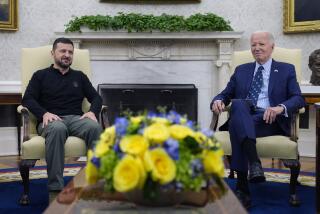Pentagon mulls NATO request for more U.S. drones in Libya campaign
- Share via
Reporting from Washington — The Obama administration is considering sending more Predator drones and other surveillance planes to bolster the NATO air war in Libya, and has reopened a debate over whether to give weapons to the rebels seeking to overthrow Moammar Kadafi, a senior Defense Department official said.
NATO commanders requested the sophisticated surveillance aircraft after concluding that they were running out of military targets in Libya after four months of bombing and missile strikes against Kadafi’s military forces and command facilities, U.S. and NATO officials said.
The Pentagon’s willingness to consider strengthening the North Atlantic Treaty Organization force in Libya marks an apparent shift since Defense Secretary Leon E. Panetta took over the Pentagon early this month.
Panetta has emphasized that winning the war in Libya is one of his top priorities. His predecessor, Robert M. Gates, had urged European allies to do more and had stressed that the U.S. military was overstretched.
NATO commanders are especially eager to obtain more Predator drones, which can remain aloft for a dozen hours or longer, beaming live video and other intelligence data back to targeting analysts on the ground, a senior NATO officer said. The Predator drones can carry two air-to-ground missiles.
“It’s getting more difficult to find stuff to blow up,” said a senior NATO officer, noting that Kadafi’s forces are increasingly using civilian facilities to carry out military operations. “Predators really enable you study things and to develop a picture of what is going on.”
The Pentagon sent NATO several Predators to augment the Libya operation three months ago. Additional drones would permit expanded surveillance of facilities where the alliance suspects Kadafi and his inner circle are directing attacks, the officials said.
“We are looking at all the possibilities” for sending drones and other surveillance aircraft, said the senior Pentagon official, who spoke on condition of anonymity because the debate is ongoing.
The official said sending more Predator drones would require transferring them from war zones in Afghanistan and Iraq, and counter-terrorism operations elsewhere, and that some U.S. officials and senior commanders oppose the move.
“The reason why this is hard is that everything we have is currently committed elsewhere,” the official added.
Ali Aujali, the rebels’ envoy in Washington, said the rebel leadership had long ago put in a request for U.S. military aid. He said the need is for small arms, antitank weapons and four-wheel-drive vehicles for the desert, as well as equipment to detect minefields laid by Kadafi’s forces.
“We can’t get rid of this man by throwing eggs at him,” Aujali said.
The war in Libya has cut the country in half. Kadafi still controls the capital, Tripoli, and much of the surrounding area in the west. The rebels hold the country’s eastern region. Giving the rebels lethal aid for the first time would signal that the White House has decided to deepen the U.S. role in hopes of turning the tide in the rebels’ favor.
The Obama administration has furnished the rebels with uniforms, boots, radios, tents, medical supplies and other nonlethal assistance since April. But the United States declined to provide weapons and other lethal aid, in part because Washington did not formally recognize the rebels.
That hurdle was crossed last week when Secretary of State Hillary Rodham Clinton announced that the United States would join more than 30 other nations in recognizing the rebel leadership coalition, known as the Transitional National Council, as Libya’s government.
“Now that the recognition has taken place, I think that discussion” of providing military aid “will be back on the table,” the senior Pentagon official said.
France and several other countries have acknowledged providing small arms and other military aid to the rebels. Any U.S. decision to send assistance would be made in consultation with allies, Defense Department officials said.
The fighting in eastern Libya has appeared stalemated for weeks. In the west, rebels in the Nafusa Mountains and the coastal enclave of Misurata have made slow progress in their drive toward Tripoli.
With Kadafi refusing to step down despite the NATO bombing, the Obama administration has gradually accepted that a solution to the crisis could involve letting him stay in Libya.
The White House spokesman, Jay Carney, said this week that the administration continued to believe that Kadafi had lost legitimacy and needed to give up power. But he said the United States would not make a determination about where Kadafi should go.
The immediate issue for the Pentagon is whether to meet NATO’s request for more Predators and other surveillance planes.
The Pentagon currently has assigned enough Predators to the operation to keep two over Libya around the clock, U.S. officials have said. In addition, the U.S. has provided a Global Hawk drone — an unarmed high-altitude surveillance plane — and dozens of other manned aircraft, which conduct surveillance, intelligence collection, aerial refueling and other support missions.
Most of the strikes against ground targets have been carried out by manned aircraft from France, Britain and a few other countries. But U.S. Predator drones also have carried out 64 strikes against ground targets since April, according to the Pentagon.
NATO spokeswoman Oana Lungescu declined to comment on the alliance’s request to Washington. She said NATO has “got the assets that we need right now” to continue carrying out the air campaign.
“It’s a complex situation,” she added. “It’s a very fluid situation, and that’s why ISR is key.” ISR stands for intelligence, surveillance and reconnaissance.
NATO’s formal request for more surveillance planes did not specifically ask for Predators, officials said, but alliance officials made it clear in discussions with U.S. officials that their preference was for more drones.
Since the NATO bombing campaign began in March, it has damaged or destroyed about 570 Libyan military bases, bunkers and other unspecified “facilities”; 355 air-defense missiles; more than 500 tanks and other armored vehicles; and an estimated 860 ammunition dumps, according to statistics released by NATO.
Times staff writer Paul Richter contributed to this report.
More to Read
Sign up for Essential California
The most important California stories and recommendations in your inbox every morning.
You may occasionally receive promotional content from the Los Angeles Times.











